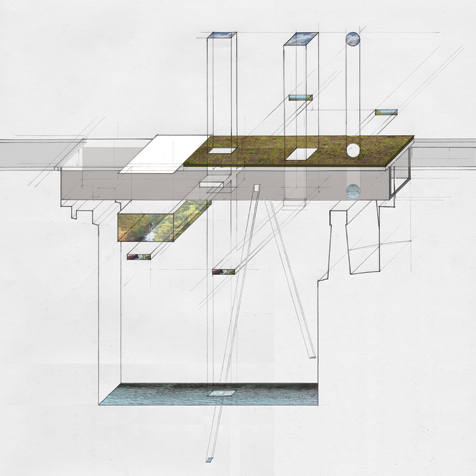












The Heavy/Light House project involves the conversion of a privately owned, abandoned railroad trestle into a guest house for one or two travelers. The program calls for a full bathroom, one bed, a small efficiency kitchen, dining area, living room and deck.

The Cadyville trestle, built as part of the Delaware and Hudson railroad in 1879, spans the Saranac River in upstate New York, about 10 miles west of Plattsburgh. The Cadyville Bridge was built as part of the Chateaugay Branch of the Delaware and Hudson railroad in 1879. This branch of the D&H was first built to deliver coal and supplies to the State Prison at Dannemora. It was later extended to the Lyon Mountain iron ore mines and by 1887 it had reached the town of Saranac Lake in the Adirondack Mountains.

Inspired by the engineer’s diagram of a load-bearing beam, the programmatic elements and activities of this house are understood as “loads” on the bridge, operating in directions perpendicular to the long directional axis of the trestle. While circulation through the house parallels the direction and path of the original tracks, other activities such as sleeping, dining, washing, and “lounging” interrupt this movement, generating spaces and apertures that allow the occupant to contemplate the surrounding environment. Sky boxes, window extrusions and holes in the floor manifest the architectural extension of these hovering programmatic elements. (For instance: the glass dining table floats between river and sky, pinned in place by views of the horizon.) Thus, these loaded spaces (along with their corresponding bodily perceptions) are suspended within the space of the bridge, hovering in stasis, yet extending to the outside world, simultaneously rendered as heavy and light.

The idea of a bridge and the idea of a house are fundamentally antithetical. The bridge is about conveyance: movement along a line, enabling safe passage from one side to another. A house, on the other hand, is about coming to rest, stasis, dwelling. To combine bridge with house, to run them together, is to create a collision of principles, a tension between the dynamic and the static, between movement and repose. But the idea of a “guest house” spans both of these worlds. A house for a traveler is a place for a person in motion to come to rest.